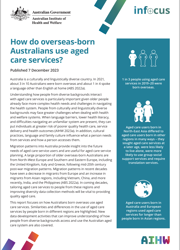Summary
Australia is a culturally and linguistically diverse country. In 2021, about 3 in 10 Australians were born overseas and about 1 in 4 spoke a language other than English at home (ABS 2022a).
Understanding how people from diverse backgrounds interact with aged care services is particularly important given older people already face more complex health needs and challenges in navigating the health system. People from culturally and linguistically diverse backgrounds may face greater challenges when dealing with health and welfare systems. When language barriers, lower health literacy, and difficulties navigating an unfamiliar system are present, they can put individuals at greater risk of poorer quality health care, service delivery and health outcomes (AIHW 2023a). In addition, cultural practices, language and family culture influence what a person needs from services and how a person accesses them.
Migration patterns into Australia provide insight into the future needs of aged care service users and are useful for aged care service planning. A large proportion of older overseas-born Australians are from North-West Europe and Southern and Eastern Europe, including the United Kingdom, Italy and Greece, following mid-20th century post-war migration patterns. Migration patterns in recent decades have seen a decrease in migrants from Europe and an increase in migrants from Asian regions, including Vietnam, China, and more recently, India, and the Philippines (ABS 2022a). In coming decades, tailoring aged care services to people from these regions and improving diversity data collection methods will be vital to providing quality aged care.
This report focuses on how Australians born overseas use aged care services. Similarities and differences in the use of aged care services by people born in different regions are highlighted. New data development activities that can improve understanding of how people from diverse backgrounds access and use the Australian aged care system are also covered.



